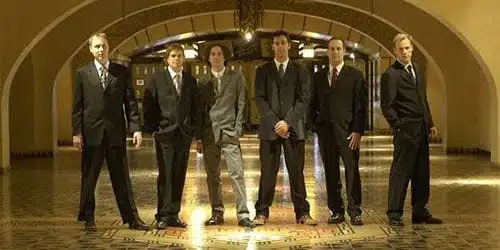
The past six years have seen Umphrey’s McGee grow from a mostly regional band to one of the top national touring acts in the country. Headlining a single night at the Fillmore is a milestone, but headlining three consecutive nights — as the Chicago group did on the third weekend in February — is a sign that a band is on its way to big things. Three nights at the Fillmore is also generally an indicator that a band will be playing a bigger venue the next time they visit the Bay Area. The band’s fans seem to know this, which explains why a large number traveled out from the Midwest specifically to see the band on this particular Fillmore run. Such travels also catalyze the jamband synchronicity circuit, where old friends run into each other and reconnect for the first time in months or even years. It takes a supreme talent to inspire fans to travel across the country for a gig, and Umphrey’s McGee has got the goods. Some music fans may find the band’s sound to be a bit heavy on the jams and light on sing-along lyrics. But for fans of progressive rock ‘n roll that consistently demonstrates a high level of instrumental prowess and stylistic diversity, few bands are as satisfying. The Saturday night show was the second of the three, and a large portion of the crowd arrived early to see the opening set by the reunited Om Trio. Those fans were treated to a sit-in by Umphrey’s guitarist Jake Cinninger at the end of the set, which served as a pleasant teaser for what was to come. Umphrey’s McGee hit the stage ready to rock. Guitarists Cinninger and Brendan Bayliss, keyboardist Joel Cummins, bassist Ryan Stasik, drummer Kris Meyers, and percussionist Andy Farag are an impressively tight unit, able to play a wide array of styles. That said, they favor prog-rock jamming above all. “Walletsworth” provided a prime example of the band’s diversity, with a power break that recycled metal riffs from the ’80s, only to segue back into some mid-tempo vocals and a groovy pop-soul jam. But if any moment summed up the vibe of the night, it had to be “The Triple Wide”, an instrumental that closed the first set with maximum style. As the song opened with a steady funk beat and a simple, yet prominent, bass line, the crowd seemed to instantly fall into a collective groove. More than one fan has noted that the song is Umphrey’s “2001”, referring to Phish’s fan-favorite cover of Deodato’s early-’70s cosmic funk arrangement of “Also Sprach Zarathustra”. The beat and groove of the intro are quite similar and there’s no doubt that Phish are a prominent influence. But the song soon takes off in other directions, showing that Umphrey’s McGee have plenty of creative juices of their own. The song went to still another level tonight when Sound Tribe Sector Nine’s David Murphy appeared onstage to take over bass duties mid-song and pump up the jam to even higher levels. Unlike the competitive rivalries that sometimes pop up in the alternative and indie-rock worlds, the jamband universe has always been one where a mutual camaraderie is common and opportunities to jam with members of other bands are sought. This is exactly what happened with STS9’s Murphy joining the band: the jam built and built, sending the crowd into a celebratory frenzy. It was the climactic type of jam that left the crowd floating on a cloud during the set break, with ecstatic smiles on everyone’s faces. The second set featured one stellar jam after another, including teases from Jimi Hendrix’s Band of Gypsies album, a bust-out cover of Eric Clapton’s “Layla”, and a stunning encore of the Smashing Pumpkins’ “Rhinoceros”. These covers go a long way toward demonstrating why Umphrey’s McGee is slowly but surely growing into a phenomenon. “Layla” was delivered with a soulful precision that paid homage to the classic-rock era, while “Rhinoceros” did the same for grunge. In between, a slew of original material mixed influences from across the entire rock spectrum in a way that few bands can dream of. (“Rhinoceros” is also a song that the Pumpkins failed to play during their 12-night residency at the venue last summer.) The diversity of influences and unpredictability of crowd-pleasing covers has led many fans to see the same qualities in Umphrey’s McGee that they saw in Phish. And while it’s true that “Layla” and “Rhinoceros” were both covered by Phish in 1998, that was ten years ago: a huge void was left by the band’s retirement in 2004. Sure, a number of bands have stepped up to try and help fill that void, but it seems as if none can break through to the arena-rock level. The odds of such a phenomenon occurring again are long, but Umphrey’s McGee are a train that’s picking up steam, and there’s no telling where the tracks might lead.
